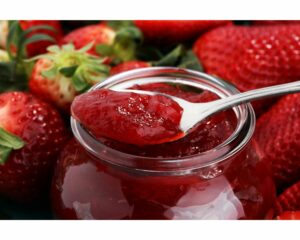Jammin’ It Up With Local Strawberries
go.ncsu.edu/readext?1000039
en Español / em Português
El inglés es el idioma de control de esta página. En la medida en que haya algún conflicto entre la traducción al inglés y la traducción, el inglés prevalece.
Al hacer clic en el enlace de traducción se activa un servicio de traducción gratuito para convertir la página al español. Al igual que con cualquier traducción por Internet, la conversión no es sensible al contexto y puede que no traduzca el texto en su significado original. NC State Extension no garantiza la exactitud del texto traducido. Por favor, tenga en cuenta que algunas aplicaciones y/o servicios pueden no funcionar como se espera cuando se traducen.
Português
Inglês é o idioma de controle desta página. Na medida que haja algum conflito entre o texto original em Inglês e a tradução, o Inglês prevalece.
Ao clicar no link de tradução, um serviço gratuito de tradução será ativado para converter a página para o Português. Como em qualquer tradução pela internet, a conversão não é sensivel ao contexto e pode não ocorrer a tradução para o significado orginal. O serviço de Extensão da Carolina do Norte (NC State Extension) não garante a exatidão do texto traduzido. Por favor, observe que algumas funções ou serviços podem não funcionar como esperado após a tradução.
English
English is the controlling language of this page. To the extent there is any conflict between the English text and the translation, English controls.
Clicking on the translation link activates a free translation service to convert the page to Spanish. As with any Internet translation, the conversion is not context-sensitive and may not translate the text to its original meaning. NC State Extension does not guarantee the accuracy of the translated text. Please note that some applications and/or services may not function as expected when translated.
Collapse ▲
Local strawberries from South Carolina are starting to appear in the stores. Our North Carolina ones will be right behind them. If I close my eyes, I can just taste homemade strawberry jam on warm biscuits. Here are some tips for making tasty, shelf stable or freezer jams.
You want to start off with fresh strawberries. The fresher your fruit the more tasty your jam. You do have some choices after that as to how you want to make your jam. Do you want to use commercial pectin or not, do you want to use a boiling water bath to seal up your jam in jars or make freezer jams that will keep in the refrigerator? Let’s cover some of these choices so that you can plan ahead for what you want to do this year.
Jam is typically made from crushed or chopped fruits and sugar. Jams need acid, pectin and sugar to create a good set or gel. Let’s look at each of these and see their role in making a good jam.
Acid: The proper level of acidity is critical for gel formation. If there is too little acid, the gel will never set; if there is too much acid, the gel will lose liquid (weep). Most fruits have enough acid but there are a few that are lower in acid, such as figs. Recipes for those fruits will include adding acid such as lemon juice to ensure that the jam is acid enough to be canned.
Pectin: Fruits naturally have pectin and acid but it can be easier to get a good gel by adding commercial pectin. My advice is to follow the recipes that come with the pectin you are using. Those amounts of ingredients and steps are specific and result in the best product. They will also indicate at which step you add the pectin since the order can be different based on the type of pectin you are using. Liquid pectin is added after the fruit and sugar are heated while powdered pectin is added at the beginning before you add the sugar. Commercial pectin also includes some additional acid to help support a good gel.
Sugar: Sugar serves as a preserving agent, contributes flavor, and aids in gelling. Cane and beet sugar are the usual sources of sugar for jelly or jam. Do not try to reduce the amount of sugar in traditional recipes. Too little sugar prevents gelling and may allow yeasts and molds to grow. You may be able to use a low-sugar pectin recipe but you will notice there is still sugar in these recipes and are not very low in sugar. You can find low-sugar or sugar-free recipes but these will usually be for freezer jams where the freezer is providing the prevention of mold growth.
Another key rule is to not double batch your recipes. If you want to make more, make up multiple individual recipes. Increasing the batch size can result in jam that won’t gel and is more like a syrup.
You may decide you want to make strawberry jam that does not have commercial pectin. Here is a link to a tested recipe from the University of Georgia’s National Center for Home Food Preservation. Jams without Added Pectin This recipe covers ways to test for the gelling point at which point you will fill your jars.
If you don’t want to take the time to preserve your jam with a Boiling Water Bath, you can always make a freezer jam. Here is a strawberry freezer jam from Colorado State University, Extension. Strawberry Freezer Jam
For other tips on making jams or other sweet spreads contact our office or email Cathy Hohenstein at cathy_hohenstein@ncsu.edu




